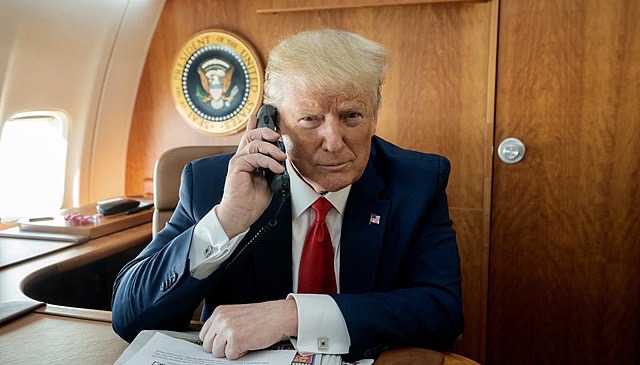In a bold diplomatic move that has captured global attention, former U.S. President Donald Trump has re-entered the international stage by initiating direct communication with two of the most pivotal figures in today’s geopolitical conflict — Russian President Vladimir Putin and Ukrainian President Volodymyr Zelenskyy. The objective? To forge a path toward a ceasefire in the bloody and prolonged Ukraine-Russia war.
This surprise development follows recent political moves that underscore Trump’s intention to influence global affairs beyond U.S. borders. After holding talks with UK Labour leader Keir Starmer and French President Emmanuel Macron, Trump has now turned his focus to Moscow and Kyiv. Both leaders — Putin and Zelenskyy — have agreed to the calls, scheduled for Monday, May 19, 2025.
The world watches closely as the stakes have never been higher. Peace feels both tantalizingly close and dangerously elusive. Trump claims to be optimistic, but concerns simmer, especially in Kyiv, where officials fear what compromises might be made in the name of diplomacy.
Background of the Ukraine-Russia Conflict
The roots of the Ukraine-Russia war stretch back to 2014, when Russia annexed Crimea following the Euromaidan protests that ousted Ukraine’s pro-Russian president. The move marked a severe escalation in tensions between Russia and the West, leading to years of simmering conflict in the eastern Donbas region.
Fast forward to February 2022, Russia launched a full-scale invasion of Ukraine, triggering the largest war in Europe since World War II. The invasion was met with fierce Ukrainian resistance and an unprecedented level of support from NATO countries, especially the United States.
By 2025, after years of deadly battles, sanctions, and geopolitical chess, the war has devastated Ukraine’s infrastructure, displaced millions, and created an enduring humanitarian crisis. Despite numerous peace talks and international mediation attempts, the core issues — Ukraine’s sovereignty, NATO’s expansion, and Russia’s territorial ambitions — remain unresolved.
Trump’s new diplomatic push comes at a critical time. Both sides are militarily fatigued. Civilians are paying the highest price. And the world — from Europe to Africa — is grappling with the fallout in food supply chains, energy markets, and global security.
The Istanbul Negotiation Stalemate
In early May 2025, representatives from Russia and Ukraine met in Istanbul for peace talks brokered by Turkey. While many viewed the summit as a hopeful sign, the outcome proved disheartening. Ukraine’s negotiating team entered the talks with a willingness to explore ceasefire conditions, but progress was derailed by Russia’s sweeping demands.
According to Ukrainian officials, the Russian side insisted on terms that included full recognition of the annexed territories, a permanent ban on Ukraine’s NATO membership, and sweeping demilitarization. These demands, Kyiv said, were “politically and morally unacceptable.”
Ukrainian President Zelenskyy reaffirmed that peace could only come with a restoration of Ukraine’s territorial integrity and guarantees of national security. The talks ended without a breakthrough, and tensions on the battlefield reignited soon after.
This failed summit likely played a role in Trump’s sudden decision to intervene. With traditional diplomatic channels exhausted, Trump sees an opportunity to leverage his personal rapport with global leaders to break the deadlock. Critics question his motives, but supporters argue he may be the outsider needed to disrupt a cycle of failed negotiations.
Trump’s Strategic Peace Initiative
Donald Trump’s decision to step into the heart of one of the most dangerous conflicts in the modern era is not without precedent. During his presidency, Trump positioned himself as a dealmaker with a penchant for defying diplomatic norms. From his meetings with North Korean leader Kim Jong-un to challenging NATO allies over defense spending, Trump has always favored bold, headline-grabbing gestures.
But this new initiative is different in scale and consequence. Trump, now back in the spotlight in 2025, sees a peace deal as not only a global necessity but a potential legacy-defining moment. Sources close to the former president say he believes he can “succeed where others have failed.”
His strategy includes engaging all major stakeholders — not just Ukraine and Russia — but also key European figures like Macron and Starmer. Trump’s inner circle has reportedly held informal discussions with military experts, humanitarian agencies, and even the Vatican to gauge possibilities for peace-building support.
Critics point out that Trump’s approach risks sidelining existing diplomatic frameworks, while supporters praise his unorthodox leadership style. Either way, his involvement has stirred the global pot, and the scheduled calls with Putin and Zelenskyy could reshape the entire trajectory of the war.
Scheduled Calls with Putin and Zelenskyy
Today, all eyes turn to the much-anticipated phone calls between Trump and the two key figures in the conflict. The Kremlin has confirmed that Putin will speak with Trump at 5 p.m. Moscow time. Meanwhile, Trump’s team has coordinated with Kyiv to arrange a follow-up conversation with President Zelenskyy shortly after.
While the exact agendas of the calls remain under wraps, insiders suggest Trump will propose a phased ceasefire plan that includes humanitarian corridors, international peacekeeping oversight, and a temporary freeze on military offensives. Whether either leader is willing to entertain such proposals remains a crucial unknown.
Putin, known for his strategic patience and hardline stances, may see the call as a chance to exploit divisions in the West or to test Trump’s resolve. Zelenskyy, on the other hand, faces a more delicate balancing act — welcoming any genuine attempt at peace while guarding against backdoor deals that might undermine Ukraine’s sovereignty.
These calls could represent either a diplomatic breakthrough or another failed chapter in the quest for peace. But their very occurrence marks a shift in the dynamics of the war — one where Trump is now a central figure, whether the world likes it or not.



